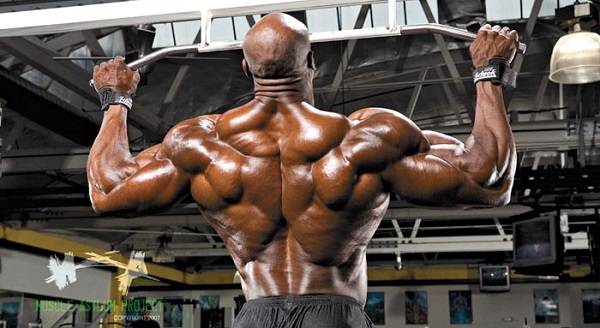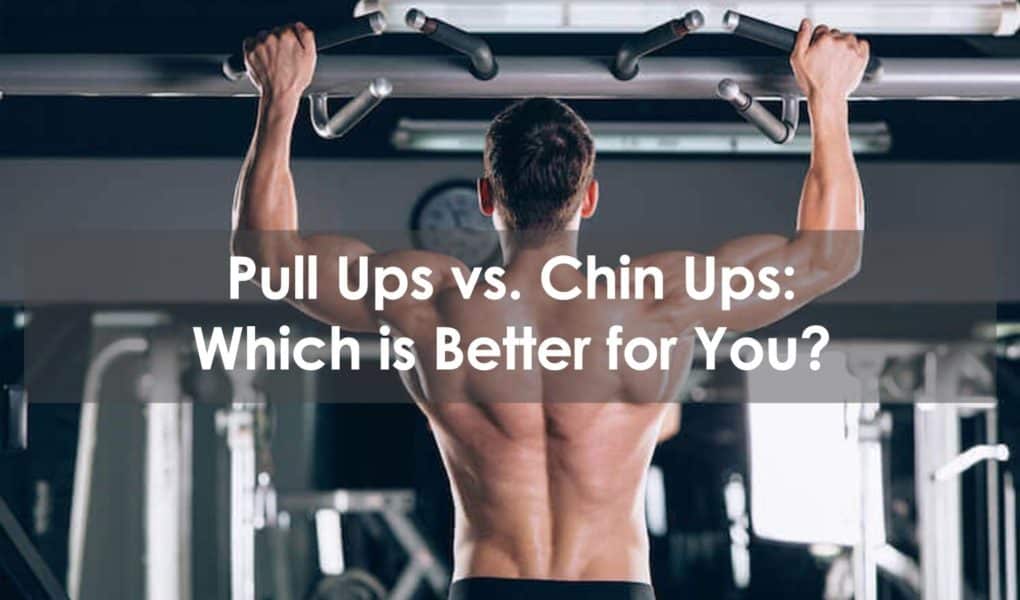When it comes to comparing pull-ups and chin-ups, you might say to yourself, hang on, aren’t they the same thing? How can you compare the same movements? But in actual fact, they are different exercises.
In this article, I will explain the differences, similarities, variations in difficulty, and primary muscles worked. Are the pull-ups and chin-ups effective movements for building muscle mass and strength? If so, which one is the more effective and efficient?
Let’s take a look.
Pull Ups Vs. Chin Ups: Which Is Better?
If you take with any respectable professional strength coach or sports scientists, they’ll tell you the same thing, pull-ups and chin-ups are two of the most effective bodyweight movements anyone can perform.
Pull-ups and chin-ups are excellent exercises for building overall strength and muscle mass, particularly in the lower and upper back, shoulders, lats, and biceps.
In terms of physical conditioning, both pull-ups and chin-ups are very physically demanding and require a decent amount of strength even to perform just one. That’s why most militaries worldwide use them as a base foundational fitness test for new and existing recruits.
During the test, both the supinated grip and the pronated grip can be used to perform and or complete the movements in the required time. So if you think carefully about the previous sentence, it actually tells you a lot.
What it says is that the military considers both the pull-up and chin-up to be of equal importance and that in the field, having the strength and ability to use the overhand grip and underhand grip is a matter of life and death.

So now we get to the 65 million dollar question, which exercise is more effective? The pull-up or chin-up? The answer is more straightforward than you might think. As with most things in life, balance is of the utmost importance, and it’s no different when it comes to exercise. Performing both the pull-up and chin-up equally will undoubtedly give you the best results.
Although they do target slightly different muscles, the reality is that both the pull-up and chin-up do actually work for the same muscle groups. Monkey bars and lat pull-downs are also similar in that they both require minimal equipment and are an excellent milestone exercise.
So for most people, that’s all they need to know; there is no real benefit of delving deep into the minutia of how what and why each exercise works in particular muscle groups; that’s for sports scientists to study. Our job is to smash out the workouts and get real gains.
As I mentioned, you can perform one or the other, but in doing so, you are robbing yourself and your body of full muscle development. I would highly recommend that you consider performing both the pull-up and chin-up to guarantee you are getting the most effective and efficient workout in a limited time.
Hitting the muscles from all angles is an excellent way to overload the muscle, which forces them to grow; just don’t forget about your recovery.
What Are Chin Ups And Pull Ups?
The main difference between a chin-up and a pull-up is the grip. The chin-up requires you to use what we refer to as a “supinated grip or palm facing you,” while the pull-up utilizes the “pronated grip or palm facing away from you.” A wide grip is also an option along with the narrower grip.
Which Muscles Do The Chin-Up Work?
The muscle groups that the chin-up targets are mainly in the upper body; that being said, a fair amount of core strength is required to perform the movements correctly. Proper form is essential.
- Traps, mid and lower
- Shoulder Extension
- Chest
- Teres Major
- Core / obliques
- Forearms and improved grip strength.
- Biceps and
- Lats
What Is A Pull-Up?
As I mentioned earlier, the main difference between the two exercises is that the movements use different grips. Both the chin-up and pull-up require you to pull your body up from a hanging start, with the goal being to lift yourself as high you possibly can.
The pull-up uses a pronated grip, and you can use either a close grip or wide grip, which is generally 5 -7 inches apart or roughly shoulder width.
- Forearms
- Core / abs / obliques
- Chest
- Biceps
- Rhomboids
- Upper Back Muscles
- Shoulder adduction
- Lower Back
- Rear delts and
- Traps
So you can clearly see from the muscle groups I’ve listed above is that both the pull-up and chin-up are legitimate old-school compound movements that develop upper body strength and overall muscle activation.
One closing point that I would like to make is that the pull-up and chin-up are quite difficult movements to perform and require a fair amount of base strength and fitness. That being said, even as a beginner, I would recommend you start implementing both these body weight exercises into your workout routine.
They’ll provide you with a better well-rounded base, and remember, don’t be embarrassed if you can only perform one or two; everyone needs to start somewhere. Even using resistance bands to start is not a bad idea, even they can help build upper body muscle.
Pull Ups vs. Chin Ups: Which Is Better For Massive Bulging Biceps?
When it comes to the bicep, most people do not realize that there are actually two heads of the muscle, both of which perform the same movements; Elbow flexion and supination and subsequently supination in your forearm.
With that being said, when you perform pull-ups correctly, they will challenge the bicep muscle and arm muscles to work and therefore grow in strength and size.
Obviously, the biceps are in a much stronger anatomical position when it comes to providing strength for the pull-up; this is mainly because of the supinated grip being used. Chin-ups are an excellent movement for targeting the biceps and shoulder blades, again due to the narrow grip position.
If you want well-rounded, big muscular biceps, then you can’t go wrong by implementing both of these movements into your workout program. You’ll definitely start seeing muscle gains.
So basically, if you were forced to choose either the pull-up or chin-up to build big guns, then the chin-up is slightly, just slightly more effective than the pull-up. The grip, the neutral grip width, and the number of reps you perform all play a pivotal role in the overall development of big biceps.
What Are The Benefits Of Performing Pull ups And Chin Ups?

The eccentric pullups and chin ups are essential exercises in the overall development of everyone from stay-at-home moms to professional athletes; both these movements are excellent for everyone.
Let’s take a quick look at some of the benefits that both these exercises provide.
Foundational Testing Movements
Both the pull-up and chin-up are a great way to gauge your fitness, body composition, and strength levels no matter your fitness level; that’s the beauty of the upper body exercises, they’re subjective on how much each individual weighs.
If you’re a beginner, you may only be able to perform 1-2 pull-ups or chin-ups, but the feeling one month later, when you can now perform 5-6, is euphoric. For more experienced gym-goers and professional athletes, these exercises are a great way of testing overall body strength and fitness levels.
If it’s good enough for the military, then it’s good enough for you; start implementing these movements today!! Remember grip variation and type of grip are critical; A solid grip is essential when performing wide grip pullups and helps alleviate shoulder injury by strengthening the shoulder joint.
No Equipment Needed
Let’s be honest, both of these movements can be performed anywhere, from places a gym with a pull-up bar to outside hanging from a strong tree branch, pretty much anywhere. They help really help with shoulder health and shoulder mobility.
This makes them ideal movements for beginners or people who don’t attend a gym due to those costly monthly membership fees. Imagine being able to progress massively without burning a big fat hole in your wallet? Well, pull-ups and chin-ups, you can do precisely that.
They Provide Excellent Crossovers To Other Sports
Let’s face it; most people aren’t going to perform pull-ups because they want to achieve more pull-ups. They are performing them so they can improve their ability in the particular sports they are playing.
Whether it be basketball, football, baseball, or soccer, almost every sport can benefit from the crossover benefits of strength and flexibility levels pull-ups and chin-ups provide.
Common Mistakes
Most people struggle to correctly perform the pull-up and chin-up; this is primarily due to their perceived lack of physical strength, particularly in the shoulder muscles. The level of strength when performing bodyweight exercises is critical and using the passive hang to start will mitigate bicep activity.
Lack of strength leads to many common mistakes such as poor chin-up form, swinging too much, inadequate or incorrect neck angles, poor or inaccurate grips and grip replacement, and finally, the number of reps and sets they are trying to perform.
An excellent reminder when performing these particular bodyweight movements is to stabilize your core as you lift upwards and also while lowering. If you find you can’t do this, you need to work on separate exercises that help strengthen and stabilize your core.
Conclusion
What’s the takeaway from this article? Well, there are many, but let me simplify it for you. Performing both the pull-up and chin-up provides amazing overall benefits for fitness and strength level no matter what your fitness level.
Having a balanced workout program that incorporates both these bodyweight movements will provide long-term benefits for your overall health and well-being. Remember, it doesn’t matter what level you are at. You have to start somewhere.
Good luck.
Frequently Asked Questions
Will Pull Ups Get You Ripped?
Yes and no. What do I mean by that? Well, as most of you know, the most critical factor in getting ripped is your diet. If you have a poor diet, it won’t matter how many pull-ups or chin-ups you can perform. You can never out-train a poor diet.
Why Are Pull-Ups And Chin-Ups So Difficult?
Bear with me here; chin-ups and the wide grip pull-up are challenging to perform because they are challenging to perform. No one wants to perform an exercise they can’t do; This is the primary reason they are so incredibly challenging, and when you do try them, the muscles needed to perform them correctly have not been developed, putting you in a disadvantaged position.
Will Chin Ups Build Muscle?
In a nutshell, yes, Chin-ups are an excellent way to build body foundational strength in the upper and lower back, traps, delts, biceps, forearms, core, obliques, rhomboids, and chest. Simply put, they are a great all-around upper body workout because you’re using your entire body weight.



